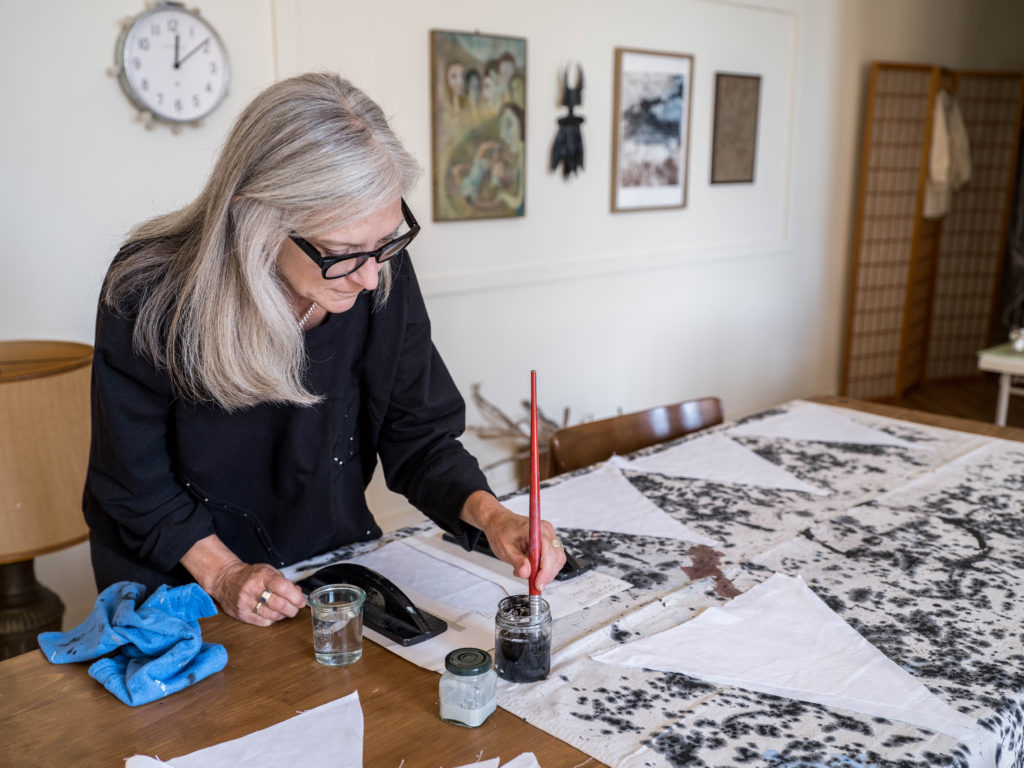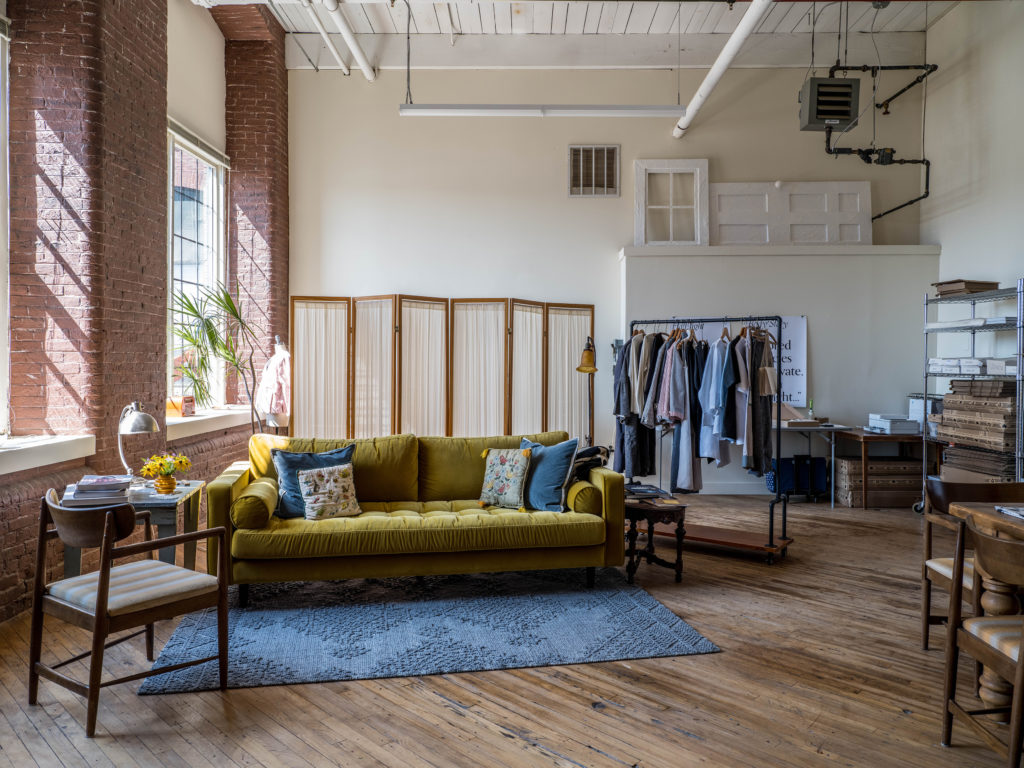This Sustainable Clothing Collection Translates Poems into Physical Garments
Maine poet and designer Catherine Fisher creates wearable works of art inspired by turns of phrase.

Tucked into a corner on the second floor of the Fort Andross Mill in Brunswick, Catherine Fisher’s light-filled studio is an airy, contemplative oasis. With large excerpts of text hung on the walls, a dressing screen arranged behind a pleasant yellow couch, and racks of garments made from linen, hemp, and organic cotton carefully organized throughout, the converted industrial space (reminiscent of New York City artist lofts) is the sort of place where one might expect a poet-cum-clothing maker to set up shop. “I don’t think of myself so much as a fashion designer,” says Fisher, who launched her eponymous business and clothing line in October of 2021. “I don’t feel it has so much to do with fashion as it does with a creative project that wants to connect with others through text and textile.” Indeed, each piece of clothing Fisher creates starts out as a poem, which is then translated into a carefully constructed garment meant to be “completed” by whoever wears it.
Fisher guides me through the studio, where she keeps a purposely small inventory of her clothing line to prevent unnecessary waste. A rack of samples holds versions of the 12 garments currently in Fisher’s repertoire, and she tells me about the poem behind each one. The composition that kicked off her entire collection is called “Half-Light,” which draws on shadow imagery to comment on how humans impact each other’s lives in both obvious and subtle ways. The top inspired by the poem reflects this sentiment with a semi-hidden panel in the back that depicts two overlapping silhouettes hand-painted by Fisher. Near the start of her poetry career, Fisher attended an event in Brooklyn, New York, called Universe In Verse, a yearly evening of poetry with over 1,000 people. In planning out the logistics of the trip, inspiration struck. “I just had this vision of a blouse,” she says, “that would be split up the back with a sort of curtain, and down the spine would be this sexy poem printed there. And, in my self- romanticization, I imagined that somebody would ask me about it, and then we would have a conversation, and I would have an interesting connection in the city.” Much like her poems taking on physical form through garments, when she returned from the trip, the idea for Catherine Fisher Clothing began to materialize.



Fisher has had numerous careers, including innkeeper, acupressurist, and personal historian, and considers herself to be a serial reinventor. The common elements in all these occupations, she says, were storytelling and connection. Her passion for sharing stories and forming bonds with others brought Fisher into the creative community of Portland, where for many years she was an eager and engaged audience member. When she was in her 40s, she met her mentor, Maine artist Bessie Moulton, who started pulling her into different projects and art shows. Fisher has harbored a great love of poetry from the time she was young, but as a self-described “very shy person,” she didn’t have the confidence to pursue it. When she turned 50, however, Fisher took a leap of faith and enrolled in a low-residency MFA program at Vermont College of Fine Arts in Montpelier to pursue her master’s degree in poetry.
When it comes to translating her poems into physical items of clothing, the materials that Fisher chooses are of the utmost importance. In traditional clothing design, the fabric used in a garment is dictated by its function (a stiffer material will be used for an article of work clothing like overalls, while a soft batting might be used in a jacket intended for cold-weather use). For Fisher, this principle is enhanced; the chosen material also reflects the meaning of the poem that the garment derives from. If the poem is about flight or the feeling of weightlessness, for example, the garment will be made from a light, airy material. Fisher also frequently incorporates specific items into each piece to get to the essence of the poem, such as the hand-painted panel in the Junco top, which depicts tiny bird tracks; the cloth book that comes in the pocket of the In Libris tunic; and the custom-made paintbrush that accompanies the Brush duster jacket.


In addition to creating wearable pieces of art, Fisher’s top priorities for her business are to be as sustainable and ethical as possible while also focusing on giving back. The fabrics and materials that she chooses, such as linen from a 100-year-old Irish company called Baird McNutt and buttons made from corozo nuts, are sustainably sourced and produced. Fisher sends her mock-ups in to be professionally sewn and produced as close to home as possible, working with a family-run company in Scarborough called Golden Thread Designs. Plus, a portion of each purchase goes to supporting both international and local nonprofits that align with the nature of the item (for example, a portion of proceeds from the Junco top support the American Bird Conservancy and the Maine Audubon Society).
When asked why she chooses to work in a state not known for a robust fashion industry, Fisher assures me the community and the level of support in Maine are unparalleled. As for future collections, she has a few new pieces in the works but doesn’t intend to produce a new line every season. Instead, she wants to plan collaborations with other Maine artists and hold events like fashion shows in her studio that will bring people together. “Poetry is an effort towards connection,” says Fisher. “I could write poems and put them in a book. Or I could make garments. But the fact that each piece of clothing I create is imbued with an idea or a question that I hope might resonate with whoever wears the garment makes a connection where there might not typically be one.”
Read More:
- This Sustainable Clothing Collection Translates Poems into Physical Garments

- World-Class Flake Salt Fresh From the Coast

- Maine’s Favorite Candle

- The Entrepreneur Turning Water Bottle Waste into Sunglasses

- A Bristol Boatbuilding Program Helps Apprentices Chart New Courses


